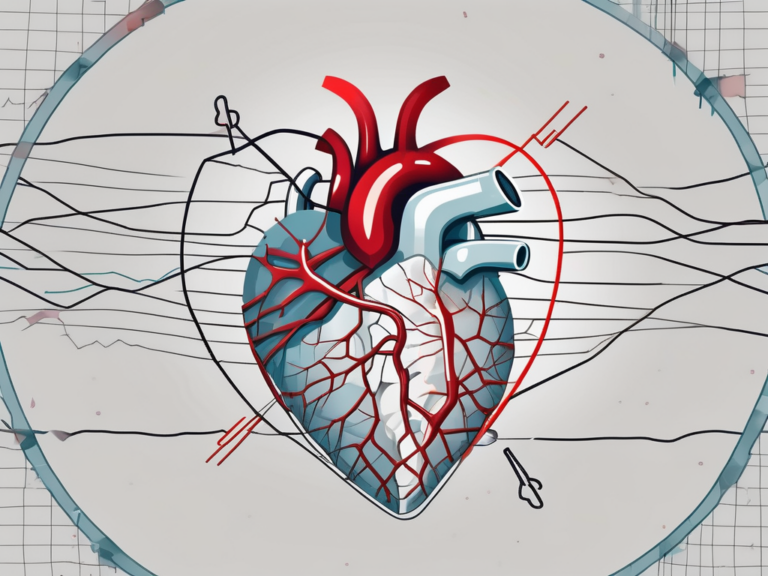Unveiling the Importance of the Accessory Nerve: Why I Heart It
Have you ever stopped to think about the incredible power of your accessory nerve? It’s a small and often overlooked part of our nervous system, but it plays a vital role in our everyday lives. As someone who has not only studied but also experienced the wonders of the accessory nerve, I can’t help but have a deep appreciation for its importance. In this article, I will take you on a journey to understand the fascinating world of the accessory nerve and why I love it so much.
Understanding the Accessory Nerve
Let’s start by exploring the basics. The accessory nerve, also known as the cranial nerve XI, is one of the 12 cranial nerves that originate from the brain. It is a complex nerve with both motor and sensory functions, connecting the brain with various muscles and organs in our body.
Now, you might be wondering, why is it called the accessory nerve? Well, it got its name because it was initially considered an accessory to the vagus nerve, another important cranial nerve.
Anatomy of the Accessory Nerve
Before we dive deeper, let’s take a moment to appreciate the intricate anatomy of the accessory nerve. It originates from the medulla oblongata, the lower portion of the brainstem, and extends down the spinal cord.
As it travels down the spine, the accessory nerve sends out branches to various muscles and organs, such as the sternocleidomastoid and trapezius muscles, which are responsible for movements of the head and neck.
But did you know that the accessory nerve doesn’t just stop there? It continues its journey, reaching even further down into the chest and abdomen, where it innervates the diaphragm, a crucial muscle involved in breathing.
Function of the Accessory Nerve
The accessory nerve has two main functions: motor and sensory.
In terms of motor function, it controls the contraction of muscles involved in head, neck, and shoulder movements. Try turning your head from side to side or shrugging your shoulders – those are the actions guided by the accessory nerve!
But there’s more to the motor function of the accessory nerve than meets the eye. It also plays a role in regulating the muscles involved in swallowing and speaking. So the next time you enjoy a delicious meal or engage in a lively conversation, remember to thank your accessory nerve for its contribution!
On the sensory side, the accessory nerve plays a role in transmitting sensations from muscles and skin back to the brain. It helps us perceive touch, temperature, and pain in the areas it innervates.
For example, when you touch something hot, the accessory nerve is responsible for relaying that information to your brain, triggering a quick withdrawal of your hand to protect yourself from harm.
So, the next time you move your head, speak, or feel a sensation on your skin, take a moment to appreciate the incredible work of the accessory nerve. It may be an “accessory” nerve, but its contributions are anything but secondary!
The Accessory Nerve and the Heart
Now, you might be wondering, what does the accessory nerve have to do with matters of the heart? Well, it turns out there’s a fascinating connection.
The accessory nerve, also known as cranial nerve XI, is primarily associated with controlling certain muscles in the neck and shoulders. However, its reach extends beyond these areas to influence cardiac function, showcasing the intricate interconnectedness of the human body.
Role of the Accessory Nerve in Cardiac Function
Believe it or not, the accessory nerve contributes to the regulation of heart rate and blood pressure. It works in harmony with the autonomic nervous system, which controls involuntary bodily functions, including those of the heart.
Through its connection with the heart’s intrinsic nervous system, the accessory nerve helps maintain the delicate balance required for optimal cardiac function. Its influence on heart rate and blood pressure can have a profound impact on our overall health.
Furthermore, the accessory nerve plays a crucial role in the body’s response to stress. When we experience heightened emotions or physical exertion, this nerve helps regulate the cardiovascular system’s reaction, ensuring our heart responds appropriately to different stimuli.
How the Accessory Nerve Impacts Heart Health
Research suggests that dysfunction of the accessory nerve can contribute to cardiovascular disorders, such as hypertension (high blood pressure) and tachycardia (rapid heart rate).
Understanding and addressing the role of the accessory nerve in heart health could open new doors for therapeutic interventions and improve patient outcomes. Isn’t that exciting?
Disorders Related to the Accessory Nerve
As incredible as the accessory nerve is, it’s not immune to the occasional hiccup. Let’s take a closer look at some disorders that can affect this fascinating nerve.
The accessory nerve, also known as cranial nerve XI, plays a crucial role in controlling certain muscles in the neck and shoulder. It is responsible for movements such as shrugging the shoulders and turning the head. However, like any other part of the body, the accessory nerve can be susceptible to disorders that disrupt its normal function.
Symptoms of Accessory Nerve Disorders
Disorders of the accessory nerve can manifest in various ways, depending on the specific area affected. Common symptoms include weakness or paralysis of the shoulder and neck muscles, limited mobility, and pain or discomfort. In some cases, individuals may also experience muscle atrophy in the affected areas, leading to further complications in movement and coordination.
If you notice any of these symptoms or have difficulty performing everyday tasks that involve neck or shoulder movements, it’s crucial to seek medical attention promptly. Early diagnosis and intervention can significantly improve the prognosis and quality of life for individuals with accessory nerve disorders.
Treatment Options for Accessory Nerve Disorders
When it comes to treating accessory nerve disorders, the key lies in identifying the underlying cause. Treatment may involve a multidisciplinary approach, including physical therapy to strengthen the affected muscles, medication to manage pain and inflammation, and in severe cases, surgical intervention to address structural abnormalities or nerve damage.
It’s essential to work closely with a healthcare team specializing in neurology or physical rehabilitation to develop a comprehensive treatment plan tailored to your specific needs and goals. By addressing the root cause of the accessory nerve disorder and implementing targeted interventions, individuals can regain function and improve their overall quality of life.
The Future of Accessory Nerve Research
The world of medical research is constantly evolving, and the accessory nerve is no exception. Let’s take a sneak peek into what the future holds for this incredible nerve.
As technology advances and research techniques become more sophisticated, the study of the accessory nerve is poised to enter a new era of discovery and innovation. Researchers are delving deeper into the intricate pathways and functions of this nerve, unraveling its complexities and potential implications for a wide range of medical conditions.
Current Studies on the Accessory Nerve
Scientists and medical researchers are actively exploring various aspects of the accessory nerve, from its role in cardiovascular health to potential connections to other bodily systems.
By utilizing cutting-edge imaging technologies and genetic mapping, researchers are uncovering previously unknown details about the accessory nerve’s involvement in motor function and its interactions with the central nervous system. These studies are shedding light on how disruptions in accessory nerve signaling can impact overall health and well-being.
They are conducting studies to better understand the effects of accessory nerve disorders, identify novel treatment approaches, and pave the way for groundbreaking discoveries.
Potential Breakthroughs in Accessory Nerve Treatment
Exciting breakthroughs could be on the horizon. New treatment modalities, ranging from advanced surgical techniques to targeted drug therapies, are being explored to address accessory nerve disorders more effectively.
With a growing emphasis on personalized medicine, researchers are investigating how individual variations in accessory nerve anatomy and function may influence treatment outcomes. This tailored approach holds promise for optimizing therapeutic interventions and improving patient outcomes in the realm of accessory nerve disorders.
These potential breakthroughs offer hope for millions of individuals whose lives can be significantly impacted by problems associated with the accessory nerve.
The Personal Connection: Why I Heart the Accessory Nerve
Now that we’ve covered the scientific side of things, let’s talk about the personal connection. Why do I love the accessory nerve so much?
The Intersection of Personal and Professional Interest
First and foremost, my passion for the accessory nerve stems from my personal experience with a family member who faced challenges related to this incredible nerve.
Seeing the impact that accessory nerve disorders had on their daily life motivated me to delve deeper into this field and search for answers. It’s a personal journey that adds an extra layer of meaning to my professional interest.
Imagine waking up every morning, ready to take on the world, only to be hindered by a nerve that refuses to cooperate. Simple tasks like brushing your teeth or combing your hair become monumental challenges. Witnessing this struggle up close made me realize the profound impact the accessory nerve can have on a person’s quality of life.
The Impact of the Accessory Nerve on Everyday Life
Moreover, the more I learn about the accessory nerve, the more I appreciate its role in our everyday lives. From something as simple as turning our heads to the complex symphony of heartbeats, this nerve quietly powers our existence.
Think about it – every time you turn your head to catch a glimpse of something interesting, it’s the accessory nerve that allows your neck muscles to work in harmony, guiding your gaze effortlessly. Without this nerve, even the most basic movements would become a struggle.
But it doesn’t stop there. The accessory nerve also plays a crucial role in the coordination of our vocal cords. It allows us to speak, to express our thoughts and emotions through words. Can you imagine a world without the power of speech? It’s the accessory nerve that ensures our voices are heard.
By shedding light on its importance, I hope to raise awareness and inspire others to recognize the wonders of the accessory nerve, just as I have.
So, the next time you turn your head, take a moment to appreciate the intricate dance of muscles and nerves working together. The accessory nerve may be hidden beneath the surface, but its impact on our everyday lives is undeniable.
In conclusion, the accessory nerve is an unsung hero of our nervous system. Its vital functions and potential impact on our health make it worthy of admiration. Whether you’re a healthcare professional, a curious reader, or someone affected by accessory nerve disorders, unlocking the mysteries of this incredible nerve is a journey worth pursuing. Let’s celebrate the accessory nerve and give it the love it deserves!






